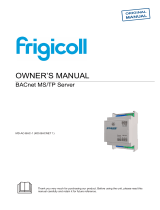
Table of Contents
1. Order Codes ........................................................................................................................... 1
2. General Informaon ................................................................................................................ 2
2.1. Intended Use of the User Manual ........................................................................................ 2
2.2. General Safety Informaon ................................................................................................ 2
2.3. Admonion Messages and Symbols ..................................................................................... 2
3. General Introducon ................................................................................................................ 4
4. BACnet Server to Modbus Client ................................................................................................ 5
4.1. Specic Gateway Introducon ............................................................................................. 5
4.2. Funconality ................................................................................................................... 5
5. Modbus Server to BACnet Client ................................................................................................ 6
5.1. Specic Gateway Introducon ............................................................................................. 6
5.2. Funconality ................................................................................................................... 6
6. ASCII Server to BACnet Client .................................................................................................... 7
6.1. Specic Gateway Introducon ............................................................................................. 7
6.2. Funconality ................................................................................................................... 7
7. Gateway Capacity .................................................................................................................... 8
8. BACnet Interface ..................................................................................................................... 9
8.1. General Descripon .......................................................................................................... 9
8.2. BACnet Client ................................................................................................................. 10
8.2.1. Descripon ............................................................................................................. 10
8.2.2. Points Denion ...................................................................................................... 11
8.3. BACnet Server ................................................................................................................. 12
8.3.1. Descripon ............................................................................................................. 12
8.3.2. BACnet IP ............................................................................................................... 13
8.3.3. BACnet MSTP .......................................................................................................... 13
9. Modbus Interface ................................................................................................................... 14
9.1. General Descripon ......................................................................................................... 14
9.2. Modbus Server Interface ................................................................................................... 14
9.2.1. Descripon ............................................................................................................. 14
9.2.2. Funcons Supported ................................................................................................ 14
9.2.3. Modbus RTU ........................................................................................................... 15
9.2.4. Modbus TCP ........................................................................................................... 15
9.2.5. Modbus Server Interface Points Denion .................................................................... 16
9.3. Modbus Client Interface ................................................................................................... 16
9.3.1. Descripon ............................................................................................................. 16
9.3.2. Points Denion ...................................................................................................... 17
10. ASCII Interface ..................................................................................................................... 18
10.1. Descripon ................................................................................................................... 18
10.2. ASCII Serial ................................................................................................................... 18
10.3. ASCII TCP ...................................................................................................................... 18
10.4. Address Map ................................................................................................................ 18
10.5. Points Denion ............................................................................................................ 19
10.6. Messages ..................................................................................................................... 20
IN700-485 Series
USER MANUAL Version 1.2





















